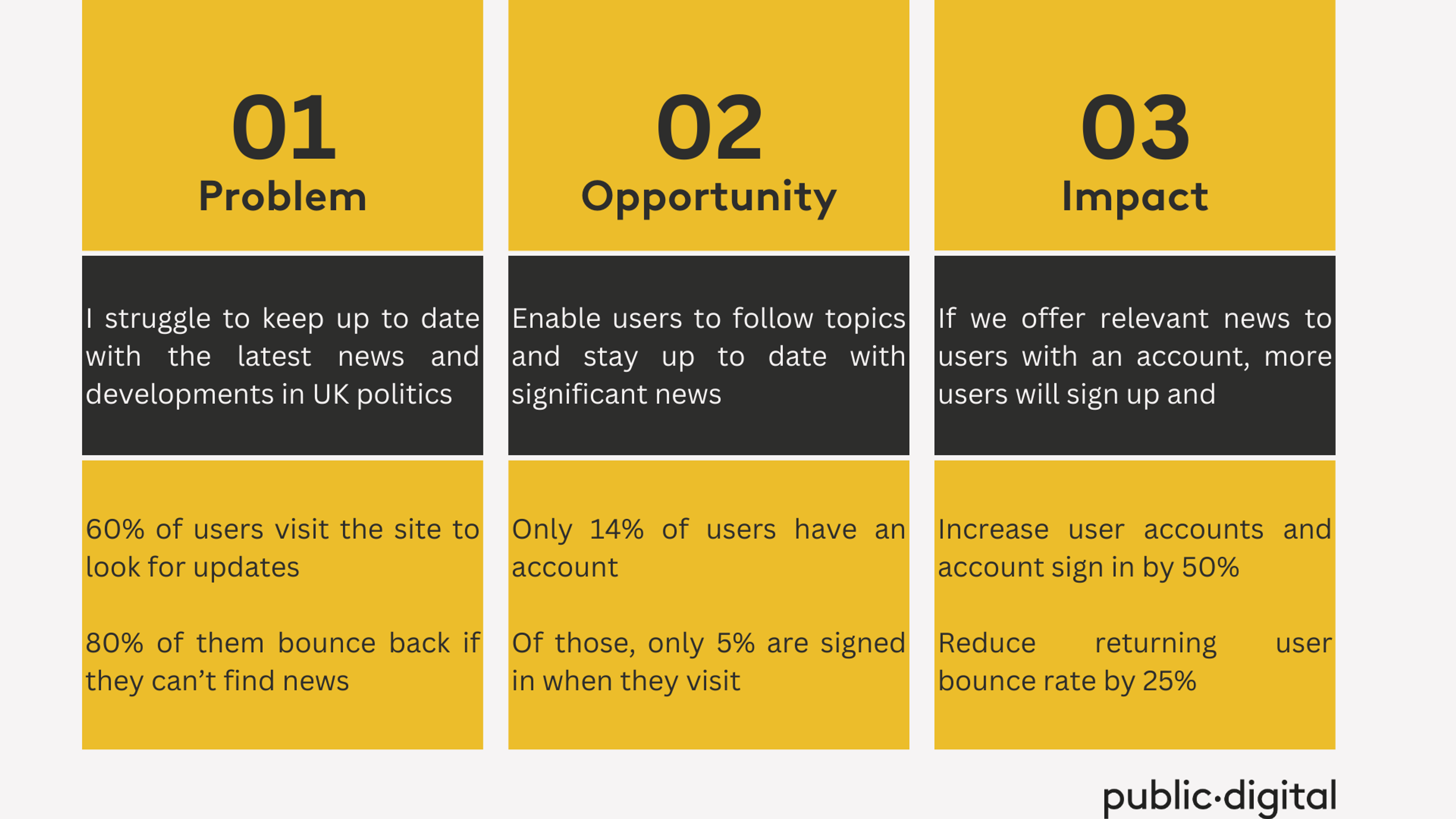
Service design
We help organisations make their services simpler, faster and more impactful by focussing their teams on users’ needs.
In any organisation, it's easy to get caught up in the pursuit of goals that may not actually deliver value to customers.
Typically, companies start from a place of aspiration or convenience when deciding on their business goals. They might want to attract more customers, or create operational efficiencies. Business goals help to create targets across the organisation. They provide clarity on what the organisation is trying to achieve commercially. If broken down into smaller increments, they can help individual teams recognise their role in the organisation’s collective direction.
However, chasing a goal that is designed purely to achieve the commercial targets of the business is unlikely to be effective. And that’s because a goal like this will fail to deliver value for the bedrock of the organisation: its customers.
A business can only exist as long as customers - or users - find their products and services desirable. If the needs of customers aren’t met, they will go somewhere else.
As I’ll explore in this post, you can only achieve commercial goals by understanding what your customers need, and by using those wants as a springboard from which to scope out opportunities.
A user need describes whatever a typical customer might be lacking in their current experience of using your service or product. That could be anything from a lack of sufficient signposting to guide them to the information they need, or long wait times to get through to a member of your staff.
In order to identify what those needs are, you need to become radically user-focused, and use research and data to work out where your service design is failing its customers. Once you identify a specific user need - something your customers want - you can unlock the potential to meet a mutually beneficial commercial goal - something your business wants.
For example, an online news site might want to see more users making accounts on their website. This describes a business goal, not a user need. It is something that the organisation wants, not something the customer wants.
However, if the organisation manages to identify a problem for users, such as visitors to the website struggling to find articles relevant to their interests, that problem will present hidden opportunities. For instance, users might start to make accounts if those accounts held the promise of personalised email alerts, and therefore quicker access to news articles about topics they are interested in. Essentially, if the solution to a business goal also solved a user problem.

The most successful businesses understand that problems spell opportunities: commercial success is only possible by understanding and solving problems for users.
Public Digital’s experience with clients has shown us time and again how powerful it can be to adopt a radically user-focused approach, transforming customer needs into commercially viable opportunities.
Back in 2021, one of our private sector clients was undergoing a cost-saving exercise. Their business goal was to cut costs, so they were seeking opportunities to reduce spending specifically in their contact centres.
Starting with the user needs rather than the business goal, we began by looking at the data to identify the problems users were experiencing in their interactions with contact centres.
The first thing we noticed was that the data itself had gaps. The satisfaction scores for contact centres, based on customer feedback, were high, and implied that there were no problems for users. But digging deeper, we discovered that these satisfaction scores weren’t measuring the feedback of customers who had dropped out of the service and gone elsewhere, and therefore were dissatisfied with the service they were receiving.
We scoped out the problems experienced by those customers who had dropped out, and identified where the service was really letting down clients.
The area of failure was in communication: Customers were not getting access to the right people to answer their enquiries. 50% of those reaching out to the contact centre were trying to speak to a specific person within the organisation for a depth expertise call rather than a general enquiries call. The contact centre, as a hub for transactional calls, didn’t have the information to respond to these specialist enquiries, and customers’ needs were not being met.
This revealed a genuine problem for the user - they weren’t getting through to the right people - as well as a business efficiency problem. If the contact centre staff were being inundated with enquiries they were unable to help with, their time wasn’t being used efficiently.
When the user problem and the business efficiency problem overlap, there is potential for real workable savings. Approaching this from the other way round - seeking to solve the efficiency problem and then the user problem - would not have produced the same results. Without drilling down to look at user needs, the data would never have exposed the problem in the contact centre and the ways in which the business was failing customers.
In fact, if the primary focus of the organisation was to achieve their original business goal of cutting costs, they might have reduced the number of people working on phones, making the customer wait times longer, and the problems encountered by users even worse.
The most successful businesses solve problems for their users. Companies that focus solely on their own needs without considering their customers' needs will not generate efficiencies or growth, nor will they deliver any value for the business.
Before you set your business goals, make sure you understand your customers’ problems and how you can meet their needs in relation to service design. Only then can you achieve long-term commercial gain and create a business that truly adds value for everyone.

Senior Director